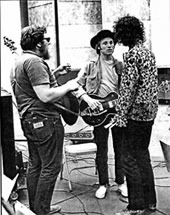
Super Session (1968)There is something wonderfully organic about Super Session, circa 1968. A young, talented musician/producer rents a studio for two days, calls up his buddies, picks some tunes to cover, and records the jam session, with only a few horn overdubs added later. This is a scenario you simply wouldn't see in the music industry these days. Today, the record company would do a cost benefit analysis, determine what percentage the artists would get and how much they'd be advanced, decide what material they could cover, select many of the musicians, and then book the studio time. Such a record could be done by an independent or even in a home studio, although the temptation to digitally tweak and edit would be irresistible. Super Session is a testament to the Paisley Decade's abundance of creativity and passion, when the bottom line was not the only measure of success. The album's history is interesting. Al Kooper, well know for his sessions with Bob Dylan, had just left the band he'd founded and with whom he'd recorded a magnificent debut--Blood, Sweat & Tears. Blues guitarist Mike Bloomfield, late from Electric Flag, was also looking for a new gig. Enlisting a great rhythm section (Harvey Brooks on bass and Eddie Hoh on drums), Kooper recorded a full day's worth of tunes with Bloomfield, whose performances are electrifying. (Albert's Shuffle and Stop feature Kooper and Bloomfield's smokey R&B chops). But sadly, apparently due to Bloomfield's heroin addiction, the guitarist left at the end of the first session, not to return. Kooper hastily, though quite appropriately, called on Stephen Stills to complete the second-day's session. The Stills-Kooper SessionStephen Stills was in between bands and a few months away from connecting with David Crosby and Graham Nash when Kooper brought him in to finish the album. Though Stills could have carried on the R&B feel of the earlier tracks, he and Kooper elected to take advantage of the former Springfield's country-rock guitar style. Stills had already perfected his faux pedal steel technique, which is created with string bends and a tremolo (or whammy) bar. This is generally a metal bar attached to the Stills plays on Dylan's It Takes a Lot to Laugh, It Takes a Train to Cry; You Don't Love Me; and Harvey's Tune (with its great BS&T-esque horn arrangement), but Donovan's Season of the Witch is the Kooper-Stills high-water mark. Stills achieves a very thin tone with his guitar and amp and uses his wah-wah pedal technique to great effect. I think Stills' early interest in percussion is directly linked to his guitar pedal control, which always lays right inside the groove. For a textbook example of this method, listen to Go Back Home on Stills' first solo record, or The Love Gangster from the first Manassas album. Super Session was one of those records that always managed to find its way onto the turntable at parties, in dorm rooms, in your darkened bedroom illuminated by black lights. It's a time capsule that still has relevance today because it celebrates creative synergy and improvisation.
|
 bridge of the electric guitar, which when manipulated, temporarily changes the tension on the strings to create a bend or modulation in pitch. The process sounds much like a pedal steel player moving a metal slide over the strings. A perfect example of this technique is in the guitar intro to Relaxing Town from Stills 2.
bridge of the electric guitar, which when manipulated, temporarily changes the tension on the strings to create a bend or modulation in pitch. The process sounds much like a pedal steel player moving a metal slide over the strings. A perfect example of this technique is in the guitar intro to Relaxing Town from Stills 2.